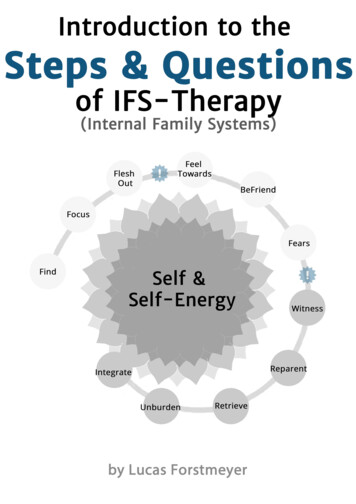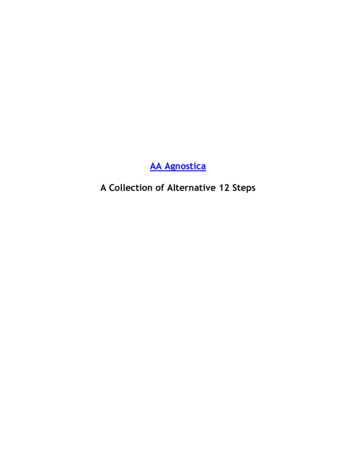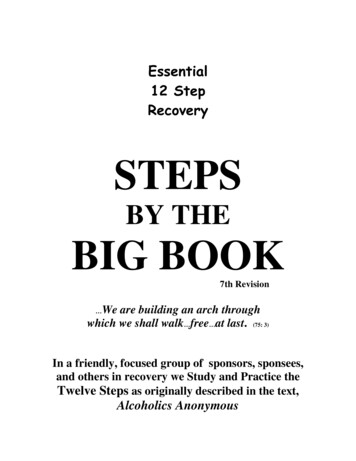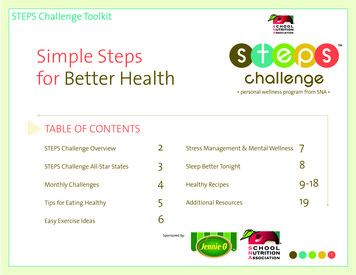
Transcription
The Steps of the IFS-ApproachThis article covers the steps of the IFS-Approach (Internal Family Systems)to therapy. First, I want to give you a general introduction to what thephases and steps of IFS therapy are. Afterwards I will present a list with themost important questions used in the IFS approach to guide people (orourselves) through the therapeutic process.What is IFS and what are these steps?IFS or Internal Family Systems is both a model of our mind and psycheand an approach to therapy.Both the model and approach work with the assumption that each personhas many Parts (subpersonalities) and that these parts strongly influence(sometimes even determine) how one feels and acts in the world. Inaddition, IFS asserts that each person has a Self (an essential/spiritual core)that is not a Part and that is inherently compassionate, calm and open.The IFS-Model gives a map for different parts, relationships between partsand interactions with the Self. The IFS-Approach gives practical tools on howto work with Parts and support the Self to be more present.The ‘Steps of the IFS-Approach’ are the steps of the therapeutic process IFSuses to work with parts that are creating problems in a person’s life. Inessence, these steps are about helping the Self and these parts tore-connect and empowering the person’s Self to help his or her own Parts.These steps are used both by Therapists to support their Clients and peopleworking with themselves to develop more compassion and empowerment tosupport themselves and their own Parts. Lucas Forstmeyerlucasforstmeyer.comFacebook: h lf/
The Steps of the IFS-ApproachIntroducing the StepsThe rest of this article is an overview of these Steps. For this I first want tointroduce a diagram I developed (open for constructive feedback):A few general points on these steps and this diagram:1. IFS distinguishes between the work with Protective Parts (Protectors)and child parts that are carrying pain from the past (Exiles). There aredifferent steps for both: The 6 F’s in light grey for working withProtectors and the Unburdening Process when working with an Exile.2. The (!) Signs represent particularly important thresholds of theIFS-Steps where the orientation shifts and we need to pay particularattention to the presence of Self or Self-Energy.3. The whole process revolves around the connection between parts(both Protectors and Exiles) with Self - this is represented by thespiral that moves closer towards the Self-Flower and the last step(Integration) symbolising the re-integration of a certain Part intoSelf-Energy and thus Self-Leadership. Lucas Forstmeyerlucasforstmeyer.comFacebook: h lf/
The Steps of the IFS-ApproachThe 6 F’s in more detailThe 6 F’s are the IFS-Steps for working with Protectors (Parts that activelydo - sometimes very distorted - things to try and protect a person fromharm and keep them functioning in life).The basic goals of the 6 F’s are- to connect with a person’s Protectors as Parts (as in, these areactivated subpersonalities and not Self),- understand why they are acting a certain way- and enable a connection between the Protector and the Self in whichthe Part is separated from the Self.For this IFS has developed 6 steps: Lucas Forstmeyerlucasforstmeyer.comFacebook: h lf/
The Steps of the IFS-ApproachFIND: Finding out with which topic and Parts we work AND then localisingthe part in or around the body. FOCUS: Focusing the attention inwards on the Part. Learning a bit about itand its qualities. FLESH OUT: Learning more about the Part in a way that supports theseparation between Part and Self. FEEL TOWARDS: Testing the Presence of Self, unblending from the Part ifnecessary to establish a strong connection between Self and Parts. BEFRIEND: Learning more about the Part and establishing a goodrelationship between Self and Part. FEARS: Asking about the deepest fears of the part that influence it to act theway it does. Usually, this points towards exiles and polarized parts.You can find a video that explains these Steps in more detail here:https://youtu.be/agigQ-AmGjA Lucas Forstmeyerlucasforstmeyer.comFacebook: h lf/
The Steps of the IFS-ApproachThe Unburdening-Process in more detail:The Unburdening-Process covers the steps that have emerged within IFS tohelp Exiles to let go of a Burden (old pain and unprocessed emotions) theyare carrying - and often have carried for years or decades.This process includes the Self being present with and holding the Exile intheir pain, helping them have a new experience and supporting them inletting go of the old pain they have been carrying.PLEASE BE AWARE: Being with Exiles is delicate work.Exiles are simultaneously fragile and holding very intense emotions andexperiences. So trying to “just unburden” an exile is both dangerous andungracious. Going to these old places without appropriate skills or supportby a person who can hold you and the Exile can lead to the system becomingmore charged and activated.So if an Exile keeps coming up in you: please get the help that is appropriate.I still want to cover the Steps of the Unburdening-Process, so you canget a clear picture of the whole IFS-Process: Lucas Forstmeyerlucasforstmeyer.comFacebook: h lf/
The Steps of the IFS-ApproachCONTACTING EXILE: Establishing a connection between the Self and Exile inwhich the Self can be present with the experience of the exile. WITNESSING EXILE: Inviting the Exile to show anything it wants to showso it can be seen, felt and understood - in what happened and how thatmade it feel.Additionally: Supporting the Exile in understanding that this happened inthe past. REPARENTING EXILE: Allowing the Exile to have a new experience. Either inthe memory of the past OR in the present. RETRIEVING EXILE: Freeing the Exile from the situation of the past andbringing it into a better situation in imagination or the present. UNBURDENING EXILE: Holding a ritual in which the Exile can let go of theBurdens it has been holding. INTEGRATING EXILE AND PROTECTOR: Finding a good place for both Exileand protector in the system and life.Also: Integrating the qualities of Being that are arising in you.You can find a video that explains these Steps in more detail here:https://youtu.be/GNouQZpFvQY Lucas Forstmeyerlucasforstmeyer.comFacebook: h lf/
The Steps of the IFS-ApproachThe Complete Flow of the IFS-Method:FIND: Finding out with which topic and Parts we work AND then localisingthe part in or around the body. FOCUS: Focusing the attention inwards on the Part. Learning a bit about itand its qualities. FLESH OUT: Learning more about the Part in a way that supports theseparation between Part and Self. FEEL TOWARDS: Testing the Presence of Self, unblending from the Part ifnecessary to establish a strong connection between Self and Parts. BEFRIEND: Learning more about the Part and establishing a goodrelationship between Self and Part. FEARS: Asking about the deepest fears of the part that influence it to actthe way it does. Usually this points towards exiles and polarized parts. CONTACTING EXILE: Establishing a connection between the Self and Exile inwhich the Self can be present with the experience of the exile. WITNESSING EXILE: Inviting the Exile to show anything it wants to showso it can be seen, felt and understood - in what happened and how that Lucas Forstmeyerlucasforstmeyer.comFacebook: h lf/
The Steps of the IFS-Approachmade it feel.Additionally: Supporting the Exile in understanding that this happened inthe past. REPARENTING EXILE: Allowing the Exile to have a new experience. Either inthe memory of the past OR in the present. RETRIEVING EXILE: Freeing the Exile from the situation of the past andbringing it into a better situation in imagination or the present. UNBURDENING EXILE: Holding a ritual in which the Exile can let go of theBurdens it has been holding. INTEGRATING EXILE AND PROTECTOR: Finding a good place for both Exileand protector in the system and life.Also: Integrating the qualities of Being that are arising in you. Lucas Forstmeyerlucasforstmeyer.comFacebook: h lf/
The Steps of the IFS-ApproachQuestions for each Step of theInternal Family Systems ApproachAbove I’ve covered the basic steps and understanding of the IFS-Approach.This can be considered the blueprint of how IFS views the therapeuticprocess, all the way from getting to know a protector via unburdening anexile to integrating both into a healthier system.In the following pages I will present to you the most important and powerfulquestions and tools that have emerged to facilitate this process. Thesequestions and expressions have emerged through decades of practice.This list alone will not allow you to fully grasp the depth and intent of eachtool or question - that is not what this list is meant to do. If you are studying IFS right now, I hope this list will be a resource tounderstand how to support the flow of a session. If you are just getting to know IFS, I hope this list can give you a feelfor the perspectives and mindset used in IFS. If you are using IFS for your personal work, I hope these questions canhelp you to be with yourself in new ways. Lucas Forstmeyerlucasforstmeyer.comFacebook: h lf/
The Steps of the IFS-Approach1. FIND Who needs your attention today? What do you want to explore today? Which part do you want to explore today? Where do you notice it? Where do you feel it in or around your body?2. FOCUS Can you turn towards that part? What is it like? How are you aware of it?3. FLESH OUT Can you deepen your access to the part?Are you aware of it in other ways?How close are you to it?Can you ask it to give you some space?What is its role?4. FEEL TOWARDS What do you feel towards this part? Can you ask it to give you some more space? Can you ask other parts to step aside?5. BeFRIEND What is the part’s role? What is its intent for you? Is it aware of you as Self? How old does it think you are? How old is this part? What is this part’s history? Lucas Forstmeyerlucasforstmeyer.comFacebook: h lf/
The Steps of the IFS-Approach Is there anything else it wants you to know? I get that. I appreciate you / what you did for me.6. FEARS What are you trying to do for me? What are you afraid would happen if you did not do your job? And what is bad about that? What would happen then? What would that mean for you? Checking in with Self: Do you believe this right now? Do you experience it like this right now? How is that for you? Are you willing to let me meet the other parts and maybe help them? Let’s assume we can do that would it let us connect with the parts? Lucas Forstmeyerlucasforstmeyer.comFacebook: h lf/
The Steps of the IFS-Approach7. UNBURDENING-PROCESS Contact⁃ What does the Exile feel?⁃ What do you feel towards the exile?Witness⁃ What do you want to show me?⁃ What do you want me to know?⁃ What do I need to know to understand how this was for you?Reparent⁃ Is there anything the part needs from you to change thissituation?⁃ Does this part need something in the situation?Retrieval⁃ Do you want to leave this place?⁃ Does this part want to be in a different place?Unburden⁃ Ask the part where it is carrying that pain.⁃ Ask the part if it is ready to let go of that pain.Integration⁃ What does it want to do now?⁃ Does it still need anything from you?8. ENDING SESSION Does any part still need something?Is there a good way to end this Session?Can you thank the parts that showed up? Lucas Forstmeyerlucasforstmeyer.comFacebook: h lf/
The Steps of the IFS-ApproachI hope this helps you to either get an idea of the IFS-Process or deepen yourunderstanding and practice with these Steps.If you have any questions or remarks, please feel free to get in touch.Love,lucasEmail: hello@lucasforstmeyer.comFacebook: elf/Website: https://lucasforstmeyer.comTo read more for yourself, I recommend the following books: Jay Earley - Self-Therapy: A Step-By-Step Guide to CreatingWholeness and Healing Your Inner Child Using IFS, A New,Cutting-Edge Psychotherapy (Recommended for individuals wantingto understand IFS and use it for their own growth) Richard Schwartz, Frank Anderson and Martha Sweezy - InternalFamily Systems Skills Training Manual: Trauma-Informed Treatmentfor Anxiety, Depression, PTSD & Substance Abuse (Recommended forTherapists wanting to use IFS in their practice. The ‘6 F’s’ Framework istaken from that book, which seems to be the latest version of theModel) Lucas Forstmeyerlucasforstmeyer.comFacebook: h lf/
attention to the presence of Self or Self-Energy. 3.The whole process revolves around the connection between parts (both Protectors and Exiles) with Self - this is represented by the spiral that moves closer towards the Self-Flower and the last step (Integrati











